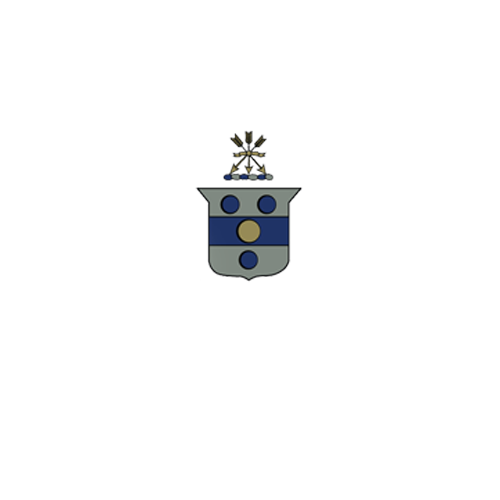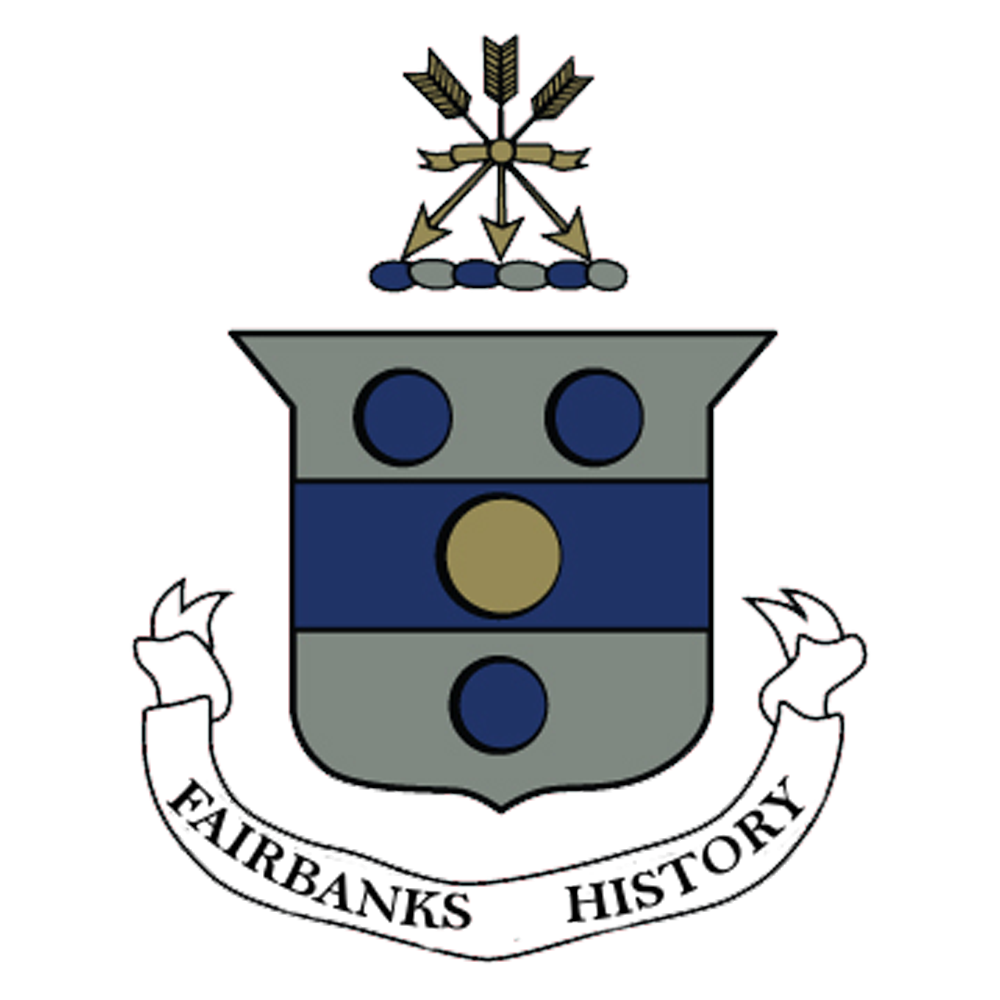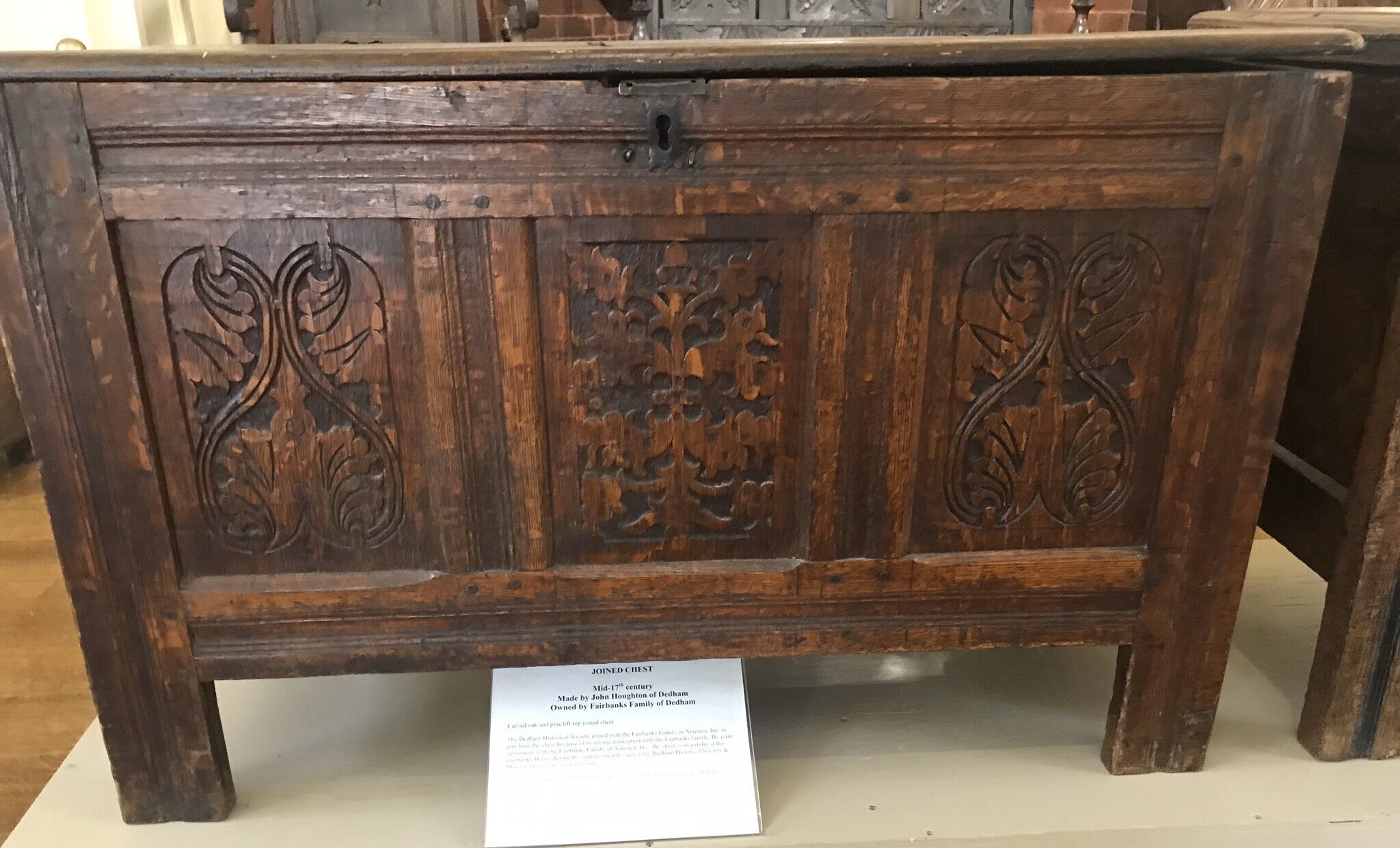Indentured Servants, Apprentices, and Others Who Were Part of the Fairbanks Family
Jonathan Fairbanks and his family were among the early settlers of the Massachusetts Bay Colony. Building a new life in the New World brought the responsibility of hard work for everyone in the family and sometimes more. The settlers cleared land for a homestead and roads. They built houses and opened virgin land to plant their crops and gardens. Any who have experienced farming today know that it is hard work even after years of tilling. Opening a field in thatch and clay clotted land with primitive equipment was especially difficult for men who knew little about farming, but their families were dependent on what they could grow.
The Fairbanks Family came from the Sowerby/Warley, West Yorkshire, England. That area was known for the cottage processing of wool and wool cloth. All except the river valleys had poor rocky soil—Sowerby means sour soil. Most families lived on the hillsides of the Pennine Mountains that barely supported a milk cow, pig, poultry, or a garden. Jonathan probably had little experience with farming when he arrived in New England.
Jonathan brought a family of eight to Massachusetts Bay Colony about 1633. He was fortunate to have sons, about fifteen, thirteen, nine, and five years old, to help start their new home and farm. It appears he needed more help.
Bringing Others into the Fairbanks Home
The Jonathan Fairbanks family invited others into their homes to help both the family and the individual achieve a living in the New World. It is believed that Samuel Bullen was an indentured servant to the Fairbanks family before or early upon their arrival in the Massachusetts Bay Colony.
George, the second son, started a business as a cooper or barrel maker. He was assisted by James Fales, probably an apprentice rather than an indentured servant.
Martha Pidge was invited into the Fairbanks family home at about age four. She remained with the family until she married.
Jonas befriended an apprentice of Joseph Kingsbury, also of Dedham. They both worked at Hammersmith (Saugus Ironworks)
After his service during the King Philip’s War, Jonathan Jr., requested custody of a young indigenous girl. The outcome is unknown.
Jonathan and Grace hired a journeyman, John Houghton, from Dedham, to build a chest for their home. That chest and a replica can be seen today.
In Massachusetts Bay Colony, like in England, it was common to have indentured servants, apprentices, orphans or young children from families who couldn’t provide for them, as well as, slaves in the homes. Most were respected and accepted positions that benefited both parties. Usually they lived in the home with the family and ate at their table. There are also incidences of abuse and poor treatment.
Indentured Servant for the Fairbanks Family
An indentured servant was similar to the position of “hired hand” or employee. In the 1600’s, an indentured servant was a contractual arrangement. The terms of the contract described the time commitment, three to seven year, usually at least four. A small regular payment for service, room and board, sometimes clothing, perhaps some form of religious and civil education were expected during their service. At the end of service a suit of clothes was typically given to the person becoming independent of the contract. (clothes were very expensive). Sometimes land or tools were provided.
During the 1600’s, many men wished to come to the new world, but didn’t have the funds for the voyage. It cost £ 5-6 for the servant’s voyage and another £ 5-6 for supplies for the individual. There were companies who would match orphans, young men, or grown men who wanted to go to the New World with those who needed help and would pay for the transportation for a contract of service.
Some men, married with children, were able to bring the whole family under their indenture, like Steven Daye, the first printer in North America. Others accompanied the master, leaving their families in England until their terms of indenture were over. Then they established themselves in the New World and sent for the families. Some were adventurous young men without means of travel. They were usually not the first sons of families that would inherit land in England. They expected to get grants of land in New England. The mother country had just experienced years of pandemic, crop failure, and economic crisis resulting in few employment opportunities there.
Samuel Bullen
Even though Fairbanks was blessed with sons old enough to do heavy work when they arrived in New England, it is believed he contracted with an indentured servant, Samuel Bullen.
Indentured servants were needed to clear the land and open the fields
for crops.
Although we don’t have documentation of Samuel Bullen’s indenture. It is recognized by the Fairbanks Family of America in their virtual tour of The Fairbanks House in Dedham, Massachusetts. https://fairbankshouse.org/virtual-tour/ and websites for Samuel Bullen’s lineage.
Samuel Bullen was born about 1617. He was a year older than John Fairbanks, Jonathan’s oldest son. At the time the Fairbanks family might have left England in 1633, Samuel would have been sixteen-years-old.
Indentured servants and apprentices were not allowed to own land in Dedham, Massachusetts, in the early years of its existence. An indenture was usually seven years. We find in the Dedham Town Records that Bullen was granted land in Dedham in 1640. He would have been twenty-three years old. (DTR, page 72)
If his indenture was the standard seven years, that would place his contract with Fairbanks starting in 1633. about the time the Jonathan Fairbanks family may have sailed from England and arrived in New World.
The year after Samuel received his land, he married Mary Morse, also from Dedham, and became a freeman. They remained in Dedham until removing to nearby Medfield. (DTR, page 75)
Apprentices Associated with the Fairbanks Family
An apprentice was bonded to a craftsman to learn a trade. Sometimes the young man or woman was placed in the home of a particular craftsman. The parents, even gentry, might pay for the privilege of the education for their child. The apprentice would live in the house and eat at the same table as the family. Their term of bond was as little as two to four years or as many as ten to twelve. At the end of apprenticeship, they were experienced enough to become a journeyman and eventually a craftsman.
James Fales
Work of a Cooper and Apprentice
James Fales was an apprentice that worked with the Fairbanks family. We do not have information about his contract, but he probably bonded under George Fairbanks to learn the trade of cooper or barrel maker about 1651. James became known as a wood turner of bowls and tableware, a carpenter, and a cooper.
Perhaps James’ apprenticeship was as short as three years. Fales was admitted into the town of Dedham in January 1654/55, the same year that Jonathan Jr. Fairbanks was admitted. (DTR, page 139) Also in 1654/55, the town granted James the same privileges granted to George Fairbanks in 1649 to use lumber off town commons (DTR, page 124).
Forge at National Parks Service Saugus Ironworks, Saugus, Massachusetts.
Another apprentice involved with the Fairbanks family was Robert Crossman. He was an apprentice as a carpenter and mechanic under Joseph Kingsbury of Dedham. Robert, a few years older than Jonas Fairbanks, was employed with Jonas at the Saugus Ironworks (Hammersmith), near Lynn in the Massachusetts Bay Colony. Hammersmith was the first successful ironworks in the Bay Colony. The two young men were given room and board by William Osborne the agent for Hammersmith. (Iron Works Papers, pages 94, 133, 143).
Jonas and Robert both worked in the forge. Anyone working at the forge was responsible for all jobs in that building. Many of the tasks in the forge required learned skills for working with iron. (Hartley, page 189, 190, 197, 198)
Robert Crossman’s apprenticeship with Joseph Kingsbury in carpentry and mechanics and Jonas’s exposure to building spinning wheels with his father and perhaps helping his brother, George, as a cooper, would have made them especially prepared to maintaining the equipment to run the forge, particularly the waterwheels. There was no distinction of their tasks other than they worked in the forge.
John Houghton
Chest made by John Houghton about 1660 for Jonathan and Grace Fairbanks of Dedham, Massachusetts
The chest can or it’s replica can be seen at The Fairbanks House https://www.fairbankshistory.com/ or The Dedham Historical Society and Museum https://dedhamhistorical.org/
John Houghton’s came to Dedham in the early days of its settlement with his family. He apprenticed under John Thurston, a joiner, framer, and carver. A joiner made furniture or other wooden pieces by joining wood. They worked with lighter wood that was finished with ornate carvings.
John Houghton became a member of Dedham the same time Jonathan Fairbanks Jr. and James Fales became proprietors, in 1654. By 1660, Houghton, no longer an apprentice, would have reached the level of journeyman, a skilled worker who has finished an apprenticeship in a trade, or perhaps a craftsman. At that time, Jonathan Fairbanks commissioned him to make a chest with intricate carving on the front. The chest and a replica can still be seen today at the Fairbanks House https://fairbankshouse.org/ and the Dedham Historical Society and Museum https://dedhamhistorical.org/
A Young Child Placed with the Fairbanks Family
In England, there were often orphans or children of families who could not provide for them. If the community found the parents could not manage their children, the community could take the children away and place them where the child would learn to work and live responsibly.
The conditions in the 1600’s were difficult. Twenty-five percent of the English population were rural poor. It was mandated that the parishes provide for these destitute individuals, which included those “overcharged with children” through taxes or other means (Bridenbaugh, p 382) . Frequently relatives or other families in a parish took these young children into their homes. They would remain with the family until they reached majority (maturity). For a young man, that was eighteen and a woman twenty-one years.
The family was responsible for the civil and religious education of the child, much like their own offspring. All children, as young as four years old, were given chores to help the family. As they grew, they took on greater responsibilities. All the while, they learned skills needed for living by doing normal daily activities.
Martha Pidge
A friend of the Fairbanks family, Michael Metcalf Sr. lost his wife in November of 1644. At her death he had nine living children. Subsequently Michael married the widow, Mary Pidge, from Roxbury, in August of 1645. The two families together included twenty children. The youngest was Martha Pidge born in January 1641/42.
They attempted to place Martha with one of her uncles in Connecticut and Virginia. The Uncles were unable to accommodate the young girl.
The Record of Births, Marriages and Deaths, and intentions of Marriage in the Town of Dedham 1635-1845 Vol. 1 & 2 edited by Don Gleason Hill Dedham, Mass, The Dedham Transcript, 1886.
https://babel.hathitrust.org/cgi/pt?id=njp.32101013827207&view=1up&seq=7
The Fairbanks offered or were asked to take Martha into their home around December 1645. Michael Metcalf, Jr. and Mary Fairbanks, Jonathan and Grace’s first daughter and third child, were married April 1644 and were expecting their first child in February 1644/45. Jonathan and Grace’s children were nearly grown. The older three children were married. Jonas was nineteen, Susan, seventeen, and Jonathan Jr. about fifteen. Jonathan and Grace accepted Martha into their home. Grace may have welcomed a young child to help with household chores. Susan would married three years later.
It is not known if Jonathan and Grace adopted Martha or if she just became an important member of the family. Martha married a friend of the family, Benjamin Bullard, in 1659, fifteen years later. They lived next door to George Fairbanks and his family in Medfield.
Even though she is not mentioned in Jonathan Fairbanks’s will of 1668 (Sayles, page 32,33), she is frequently called Martha Fairbanks Bullard on websites of Bullard lineage and in the Bullard Newsletter. In one genealogy, The Genealogy of Several Ancient Puritans by Reverend Abner Morse which includes the Bullard family, she is called George Fairbanks’s sister (Morse, page 11). https://www.google.com/books/edition/The_Genealogy_of_the_Descendants_of_Seve/Z7aSrz03lNQC?hl=en&gbpv=1&dq=Martha+Fairbanks+Bullard&pg=PA13&printsec=frontcover
These, of course can be errors in genealogical documentation, but it is frequent enough that it leads this author to believe that Martha was recognized as an integral part of the Fairbanks family.
Slaves Associated with the Fairbanks Family
People were taken captive during wars and forced to work for their conquerors since as early as 6800 B.C. In 1526, Spanish explorers brought the first African slaves to settlements in the New World. Some tribes of Indigenous people of North America were known to take conquered members of other tribes as slaves. Free the Slaves website: Slavery in History https://www.freetheslaves.net/about-slavery/slavery-in-history/?gclid=Cj0KCQiA5bz-BRD-ARIsABjT4njSX6bJrbFVgP4_om1WZepgwhDTJoVnLS-WQ2f0Y3qw4b8jSPivah8aAka2EALw_wcB
Early in the Great Migration from England, orphans and young men and occasionally women were enticed by propaganda, drink, and promise of good wages to be shipped in mass to be indentured to early settlers from Maryland to Barbados. They were often sold as slaves instead.
During fighting between the English and the Indigenous people in New England called the King Philip’s War, captives were taken on both sides. The English placed many Indigenous people on Deer Island in Boston Harbor, a bleak desolate equivalent to a concentration camp. Others were taken as slaves or sent to Barbados as slaves. Mary Rowlandson, an English captive taken from a raid of Lancaster, Massachusetts in 16715/76, wrote being commanded to work and her fear of being sold for gun powder. NARRATIVE OF THE CAPTIVITY AND RESTORATION OF MRS. MARY ROWLANDSON by Mrs. Mary Rowlandson.
Jonathan Fairbanks Jr. and the Indigenous Girl
Jonathan Fairbanks, Jr. participated in King Philip’s War as a mounted soldier from the beginning of that war. Towards the end of the war, Jonathan Fairbanks, Jr. with nine or ten other soldiers under Captain Gibbs were sent to rescue a band of Indigenous people who were escaping the Narragansets who were fighting the English. This band of people were relatives and tribe members of Job (an English given name) Kattenanit, a strong Indigenous ally of the English during the war who was integral in saving Lancaster, Massachusetts.
When they retrieved the band, Fairbanks took a young girl, described as being ten to twelve years old, onto his horse for the thirty mile ride to the English base at Quabaug, now known as Brookfield. Captain Gibbs had already granted him custody of a young Indigenous girl as was common at that time.
The troops were called to further duty and the girl, with the others of the band, were taken to Deer Island to be held. Later, on April 19th, 1676, Jonathan Jr. requested the Governor and the Council to grant him custody of the young girl. We have no information about the result of the petition.
Jonathan Fairbanks Jr.’s petition to Massachusetts Bay Council. From The Fairbanks Family In America by Lorenzo Sayles Fairbanks page 34.
We know that Deer Island was a nearly barren island with little shelter and food. Many died there or were sent as slaves to the Caribbean. Perhaps Jonathan Jr. felt he was rescuing the girl from a dismal fate.
At that time, Jonathan Jr. was married to Deborah Shepard. Together they had eleven living children. Perhaps he wanted to bring help for his wife at home. We may never know the fate of the girl or Jonathan Jr.’s intentions.
Authors note: The story about King Philip’s War and the conditions and relationships of the Indigenous people and the settlers will be addressed at a later date when blogs about 1675/76 are posted. It will also include more details about this incident.
Conclusion
The Fairbanks family invited many people into their home to live and work with them for the benefit of both the family and the individual. These individuals lived, ate, and worshiped with the Fairbanks for several years during their indenture, apprenticeship, and childhood/young adulthood. The family may have had other hired help throughout their lives, but these are the ones recognized at this time.
Other Resources
Bridenbaugh, Carl. Vexed and Troubled Englishmen 1590-1642, Oxford University Press, 1968.
Fairbanks, Lorenzo Sayles, The Fairbanks Family in America, Fairbanks Family in America, Incorporated, American Printing and Engraving Company, 1897.
https://archive.org/details/genealogyfairba00fairgoog
Hartley, E.N. Ironworks on the Saugus, University of Oklahoma Press, 1957.
Ironwork Papers, Special Collections of Baker Library, Harvard Business School.
The Early Records of Town of Dedham, Massachusetts, Vol. 3, Edited by Don Gleason Hill, Dedham, Massachusetts, The Dedham Transcript, 1886. https://babel.hathitrust.org/cgi/pt?id=njp.32101013827207&view=1up&seq=7
The Record of Births, Marriages and Deaths, and intentions of Marriage in the Town of Dedham 1635-1845 Vol. 1 & 2 Edited by Don Gleason Hill Dedham, Massachusetts, The Dedham Transcript 1886
https://babel.hathitrust.org/cgi/pt?id=njp.32101013827207&view=1up&seq=7
The Genealogy of Several Ancient Puritans by Reverend Abner Morse. 1857, https://www.google.com/books/edition/The_Genealogy_of_the_Descendants_of_Seve/Z7aSrz03lNQC?hl=en&gbpv=1&dq=Martha+Fairbanks+Bullard&pg=PA13&printsec=frontcover
Rowlandson, Mary. NARRATIVE OF THE CAPTIVITY AND RESTORATION, https://www.gutenberg.org/files/851/851-h/851-h.htm












